Choosing the right media player
by Matthew | 7 November 2012 8:30 am
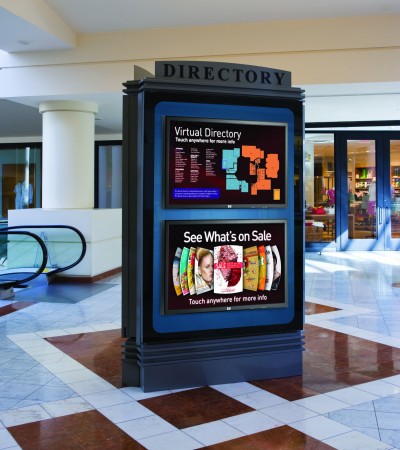 [1]
[1]Photos courtesy HP Canada
By Dmitry Sokolov
Along with displays themselves, media players are among the core pillars of any digital signage network installation. They are responsible for the smooth, accurate playback of dynamic content as it arrives from an external server. As such, they must function properly 100 per cent of the time, as any screen downtime would be immediately noticeable to passersby.
Choosing the wrong media player for a digital signage installation can lead to sub-par performance, services issues or—in a worst-case scenario—system failure. With many options on the market, however, selecting the right media player can be a daunting task.
Unfortunately, there is no such thing as a single, universally applicable media player. Since nearly every digital signage installation is unique, they exert different demands on their players.
So, finding the ‘best’ media player will be subjective, depending on the project at hand. Yet, it is possible to identify the core requirements that, across any digital signage project, will be important considerations in making the best choice for the job.
There are many such factors to consider, but three in particular will require close attention:
- Software requirements.
- The type of content that will be displayed.
- Where the network will be deployed, including how the screens will be mounted.
Software
Today’s digital signage software ranges widely in complexity. It is important to consider local technical expertise and customers’ expectations when assessing complementary media player options.
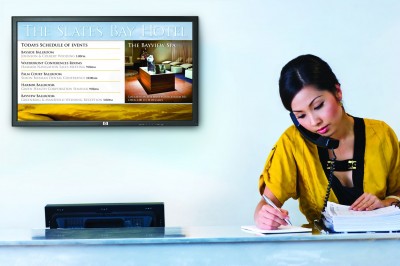 [2]
[2]Media players are responsible for the smooth, accurate playback of content as it arrives from an external server.
At the entry level, the simplest software may not even require a full personal computer-based (PC-based) player. Software based on Synchronized Multimedia Integration Language (SMIL) can run on a tiny media player embedded in a digital photo frame or a pocket-sized metal enclosure. Examples of such software include Scala Sign Channel, SignageLive Display Edition and BrightSign’s BrightAuthor.
The options are somewhat limited when choosing a player to run this type of software, as only a handful of vendors provide non-PC players. Some software vendors will require users to buy the hardware directly from them, but when there is freedom of choice, the user should look for hardware that can support high-definition (HD) video and carries a sufficient warranty, among other considerations.
A three-year warranty is ideal, as it aligns with the typical warranty period for a commercial liquid crystal display (LCD). HyperText Markup Language 5 (HTML5) support is also quickly becoming a requirement, which will help ‘future-proof’ SMIL players.
At the intermediate level, full-featured software typically requires PC-based players, where there is a much greater range of choice. As such, it will be important to consider the operating system (OS), central processing unit (CPU), graphics processing unit (GPU), random-access memory (RAM) capacity and storage before making a selection.
The vast majority of today’s digital signage software is based on Microsoft’s Windows OS, with media players to match. There are also Google Android- and Linux-based players available, but they typically require much greater attention and technical expertise.
Further, it is important to use a media player that operates on a ‘business-class’ version of the corresponding OS (e.g. Windows 7 Pro or Enterprise). Any player that uses a ‘consumer’ or ‘home’ version of Windows is probably not built for the stress and rigours of operating within a commercial digital signage network. The business versions of Windows will allow for greater functionality in terms of network management and security.
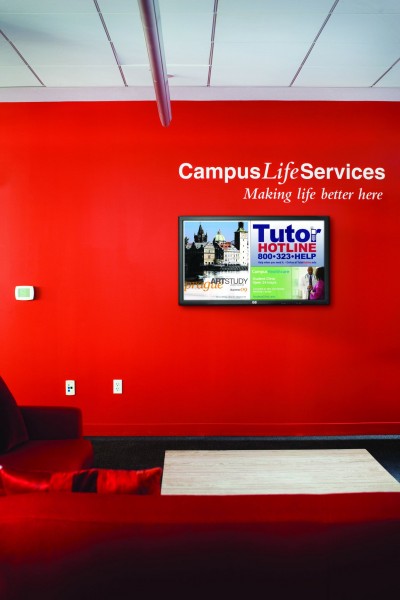 [3]
[3]The vast majority of today’s digital signage software is based on Microsoft’s Windows operating system (OS), with media players designed accordingly.
For even greater reliability and security, a lighter, stripped-down ‘embedded OS’ can be used. This can offer greater hard-disk efficiency, enhanced features like Write Filter file protection and a higher degree of stability for digital signage projects.
The CPU and GPU should be considered in tandem, checking with the vendor which of the two its software will rely on the most for performance. When software is able to offload graphics processing to the GPU, the processor’s specifications will not be as important as having a discreet graphics card in place.
Other software will be more CPU-intensive. In these cases, the CPU should be considered the key specification in determining the media player’s level of performance, since it will shoulder most of the burden.
So, it is advisable to check with software vendors whether the CPU or the GPU is the most important for the optimal performance of their products.
Where possible, it is a good idea to exceed the software vendor’s minimum system requirements for both the CPU and the GPU by 25 to 33 per cent. This will mean ‘stepping up’ at least one model above the minimum specified processor.
And if the digital signage network is expected to carry highly graphical or Flash-intensive content, the threshold will need to be increased even further, to ensure the media player is well-equipped to handle ongoing demands.
RAM and storage are also closely tied with content considerations. Generally speaking, 4 GB of RAM will be sufficient, while hard disk storage should be selected based on the needs of the content.
Content
As mentioned, when choosing a media player, it is important to consider the content that will typically be displayed on the digital sign. The type and quantity of content will have a significant influence on hardware selection.
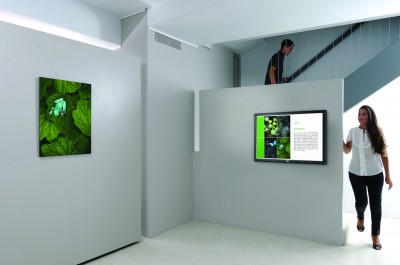 [4]
[4]The choice of media player will depend on the type of content to be displayed, as well as where and how the screens will be mounted.
HD 1,080-pixel video represents a moderate load on a single-screen layout, but when resolutions beyond 1,080 pixels are used, interactivity is added and/or video walls and other complicated multi-screen layouts are put into play, additional player performance will be required.
If digital signage installations require live video feeds, including closed-circuit television (CCTV) and live camera feeds, their media players will need to support TV or video capture cards. For these cases, players with Peripheral Component Interconnect (PCI) expansion slots are recommended, to accommodate internally mounted cards, rather than relying on external Universal Serial Bus (USB) cards, which can be dislodged or may be prone to connectivity problems.
For interactive digital signage networks, the players must support USB or serial-based touch interface connectivity. Most PC-based players will support such connectivity by default, but with SMIL appliances, the feature may be considered an extra or not even be supported at all. In this sense, the desired type of content will have an especially strong effect on the media player selection process.
Quantity of content is one of the final factors to note. Some media players, particularly ultra-small appliances, may offer only limited storage for content. While this is okay for some installations, interactive or rich-media projects tend to involve a large number of images, video files and other digital assets stored on the local player, requiring high levels of storage capacity.
Typically, PC-based media players will offer a minimum of 250 GB of spinning disk storage. Solid-state players or drives should offer no less than 16 GB, to ensure sufficient storage space.
Physical deployment
There are many ways in which media player selection will depend on physical considerations, from the size of the device and the nature of the network’s infrastructure to the environmental conditions at the planned installation locations.
Size is the most obvious of these physical considerations. Media player options available on the market today range from pocket-sized appliances to server-sized machines. The size should be considered in the context of needing to hide the device during installation, meeting the location’s mounting requirements and enabling the expansion of the system at a later date.
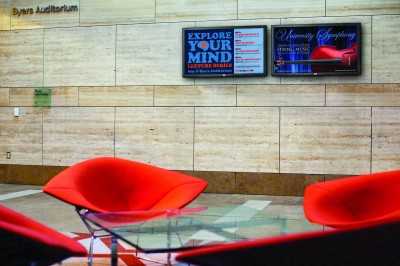 [5]
[5]Some types of digital signage software will rely more on the media player’s graphics processing unit (GPU) than others.
If the players are expected to be mounted with the displays, for example, they need to be small enough to allow for co-location. Commercial display mounts typically require a minimum of 25 to 51 mm (1 to 2 in.) of clearance between the displays and the wall; the media player just needs to fit within this clearance. A common Video Electronics Standards Association (VESA) mounting pattern is also important on the player, as it allows the direct connection of the player to the display or the mount.
If, on the other hand, the media player is to be installed within an information technology (IT) ‘closet’ away from the display—e.g. for serviceability, to enable centralized access or when using a single player for content on multiple displays—its size becomes a much less important consideration.
Much more important is a tool-less design that allows easy opening of the case to swap out components during upgrades or repairs. Coupled with a slightly larger player, this arrangement typically offers more opportunities for expanding the system in the future with additional RAM, graphics or other components.
Rack mounting—the ability to place media players on standard IT rack shelving—is also advantageous, allowing for tidier installation.
As mentioned, digital signage platforms need to be designed for the rigours of always-on operations. This requirement extends to all of the commercial hardware that will be expected to be active throughout the day, including media players with steel chassis, high-endurance capacitors, ball-bearing fans and gold-plated connectors. For a media player that will operate in a dusty, humid or otherwise not well-controlled setting, a solid-state storage drive—or even an entirely fan-less system design—is highly recommended.
When discussing the physical characteristics of the environment where the media player will be deployed, warranty considerations become especially important. A three-year warranty is a must for devices operating upwards of 12 hours per day.
Also, a full-system warranty—as opposed to a component-specific arrangement—is desirable. If anything goes wrong with the media player, the last thing anyone wants is delays associated with identifying which specific component failed before a warranty can be executed. With a comprehensive single-vendor warranty, an entire system will be replaced instantly, without the unnecessary delays.
One of the final considerations is the life cycle of the product. The digital signage sector is known for long project rollouts and demands a high degree of operational stability and constant hardware availability.
This stability is only achievable through standardized imaging—i.e. automated loading of the OS, hardware drivers and software settings on standardized hardware. Systems that can guarantee availability of the same hardware platform for three to five years are advantageous, as they reduce the number of hardware and image configurations that have to be supported in the field.
These benefits extend to software, as well, as vendors can create stable, long-lasting images of their products running on such platforms, knowing they can expect the hardware to be available and usable well into the future.
](http://www.signmedia.ca/wp-content/uploads/2014/02/G11096001102009_JPGHighres_300dpi_100pct12-400x568.jpg) [6]
[6]Media players range in size, but many digital signage networks today use devices that are small enough for co-location with the displays themselves.
Making the choice
The above are just some of the many considerations that need to be taken into account when choosing a media player for a digital signage system. Selections can even change through the life of the same project, based on individual screen installation requirements and other hardware specifications.
Not every installation calls for a small, solid-state, fan-less design or, at the other end of the spectrum, an ultra-powerful processor. What every installation has in common, however, is the demand for a flexible and reliable device. It needs to be trusted with the reputation of the digital signage business behind it.
What this means is ultimately, the ideal media player may not be a specific model per se, but rather a platform that supports the flexible processing, storage, expansion and mounting capabilities a single digital signage network may be expected to encounter across multiple project scenarios. When choosing this media player platform, it is important to consider whether it can be configured to meet the individual needs of specific projects by adding or removing components, while still maintaining a high degree of reliability, as promised through warranty and service terms.
In other words, the goal is not so much finding one ideal player as it is finding a vendor with the right mix of products, support and supplementary tools to help ensure the success of present and future digital signage deployments.
Dmitry Sokolov is retail solutions and thin clients category business manager for HP Canada. For more information, visit www.hp.ca[7].
- [Image]: http://www.signmedia.ca/wp-content/uploads/2014/02/G10952002082009_JPGHighres_300dpi_100pct.jpeg
- [Image]: http://www.signmedia.ca/wp-content/uploads/2014/02/G10412001042009_JPGHighres_300dpi_100pct.jpeg
- [Image]: http://www.signmedia.ca/wp-content/uploads/2014/02/G10630001062009_JPGHighres_300dpi_100pct.jpeg
- [Image]: http://www.signmedia.ca/wp-content/uploads/2014/02/G10412002042009_JPGHighres_300dpi_100pct.jpeg
- [Image]: http://www.signmedia.ca/wp-content/uploads/2014/02/G10630002062009_JPGHighres_300dpi_100pct.jpeg
- [Image]: http://www.signmedia.ca/wp-content/uploads/2014/02/G11096001102009_JPGHighres_300dpi_100pct12.jpg
- www.hp.ca: http://www.hp.ca
Source URL: https://www.signmedia.ca/choosing-the-right-media-player/